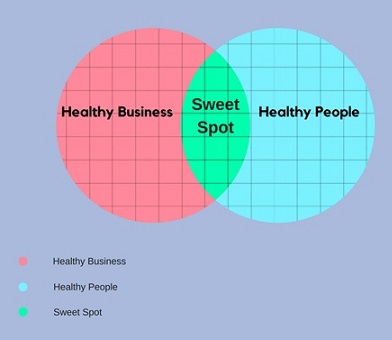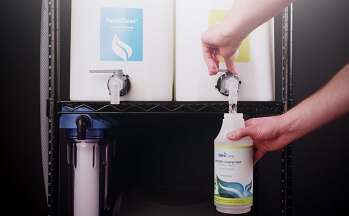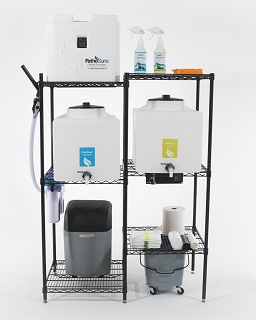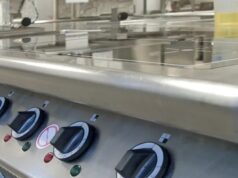The American Hotel and Lodging Association (AHLA) reports there are about 50,000 hotel properties in the United States, providing 5 million rooms, and creating 2 million jobs. In a recent year, guests spent $2.5 billion a day, $105.8 million per hour, $1.8 million per minute, and $29,398 a second. (1)

In a competitive market, successful hotels strive to meet guest expectations; including providing a clean, healthy environment.
In a survey of 1,495 American travelers conducted by research firm TNS (2), 86 percent cited cleanliness as very important when seeking a place to stay, and 80 percent would rather give up Internet access than stay in a dirty hotel.
The study, Hotel Cleanliness: Will Guests Pay for Enhanced Disinfection? (3) states: “Room cleanliness is important to hotel guests…[and there is a] marketable segment of guests [female and young travelers] who are willing to pay a premium for guestrooms that are cleaned using enhanced disinfection techniques beyond the normal room cleaning procedures.”
Meeting guest criteria for “clean and healthy” is important. (4)
This article will discuss two kinds of “healthy” housekeeping:
- The type that’s good for business, and
- That which promotes human health and wellness.
We will show how these are overlapping concepts, and that success hinges on focusing where the circles overlap. (Figure 1)
 Housekeeping for Business
Housekeeping for Business
A well-run business making a product soon learns to standardize design and production for quality and to control costs.
Since room income is a key revenue stream, standardizing how hotels produce clean rooms, the product, is key to success.
Main barriers are, lack of:
- Management knowledge of and commitment to best practices.
- The right tools, supplies, procedures, and standardization.
In other words, the hotel must work on its system for producing clean rooms.
Stephen R. Covey said: “So often, the problem is in the system, not in the people. If you put good people in bad systems, you get bad results.”
How is a “Cleaning for Health” system good business? Understanding best practices is the place to start.
Housekeeping for Wellness
The principles or best practices of wellness-centered cleaning are:
- Remove, do not add or stir dust.
- Remove, do not add contaminants.
- Remove, do not routinely poison germs.
- Disinfect touch points (e.g., tv remotes).
- Use less-toxic products and methods.
- Use residue-free products and methods.
- Use fragrance-free products and methods.
A wise man said, “if you’re not cleaning, you’re polluting” which means if you are not subtracting or removing contaminants, you are adding or rearranging them.
Subtracting Dust, Chemicals, Costs

Dust may contain pesticide residues tracked in from outdoors, phthalates from plastics, residues and or mixtures of chemicals derived from 80,000 substances in legal use that have never been tested for long-term safety, heavy metals from industry, asbestos from automobile brake linings at street level, pollen, mold fragments, skin cells, bacteria feeding on organic matter, and much more.
Fragrances in cleaners are unhealthy, as they contain endocrine disruptors, substances that are harmful even in parts per billion or trillion. Eliminate them if you can.
Disinfectants are pesticides and are regulated by the EPA. Use them sparingly and with good ventilation. Disinfect touch points only; use a targeted not shotgun approach.
Chemically-speaking, what hurts microbes often hurts people. Practice removal rather than killing of germs wherever possible and use more benign less-toxic germicides such as hydrogen-peroxide, or hypochlorous formulations produced on-site.
Chemical residues make surfaces dirty, harder to clean, and create harborage for germs as most formulas are biodegradable (i.e., germ food). Residues also enable the growth of surface biofilms which are difficult to remove.
Proper cleaning not only subtracts contaminants; it subtracts costs.

There is a bottom line benefit when you reduce buying packaged chemicals. One operation eliminated aerosols and eliminated more than $10,000 annually from its supply budget. Another switched to on-site generation of ElectroChemically Activated (ECA) solutions—acquiring the equipment without capital investment via a rental program—and saw a dramatic reduction in cleaning chemical costs.
Surfaces without residue look better and are faster and easier to clean. The use of microfiber and ECA solution for wiping chrome, or application of chemical-free dry steam vapor, quickly shows how shiny and low-maintenance chrome can be when not roughened or clouded with a chemical film.
Vacuum cleaners that remove and contain dust rather than resuspend it will lower the labor cost of subsequent dusting.
Cleaners that don’t add a fragrance to the rooms also won’t trigger sensitivities or cause respiratory concerns.
William Fisk, Senior Advisor, Indoor Environment Group, at Lawrence Berkeley National Laboratory, estimated the nationwide savings related to improvements in health and worker productivity by providing better indoor environmental quality (IEQ) in U.S. buildings. (5)
Per Fisk:
- Reduced Respiratory Illness = $6 to 14 Billion Saved Annually
- Reduced Allergies and Asthma = $1 to 4 Billion Saved Annually
- Reduced Sick Building Syndrome = $10 to 30 Billion Saved Annually
Conclusion
Standardizing housekeeping practices around a “removal of pollutants” strategy saves money up front, and makes money long-term as guests seek out cleaner, healthier properties.
Based on the foregoing, it’s clear the housekeeping “sweet spot” is where business health and human health meet.
About the Author
Allen Rathey is Principal of the Healthy Facilities Institute (HFI), Meridian, Idaho. He is the author of dozens of journal articles, promotes healthy indoor environments, and writes and speaks on systems-thinking and other facility topics.
- “Lodging Industry Trends 2015” , American Hotel and Lodging Association.
- “Cleanliness is Paramount When Booking Hotels, Study Shows”,
Study funded by CLR, 2015. - “Hotel Cleanliness: Will Guests Pay for Enhanced Disinfection?” International Journal of Contemporary Hospitality Management, 2014-15.
- “Clean rooms at top of guests’ priority lists”, Caterer & Hotelkeeper, 2007.
- How IEQ Affects Health, Productivity, 2002.







